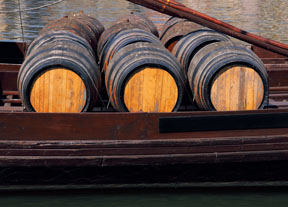| << Back |
The Wine Cellar: From Ruby to Tawny: An Intro to Port Wine
By Gordon Gilbert
What do you think of when you hear the word “port”? Landed gentry puffing cigars in the gentlemen’s clubs of London? A platter of powerful cheese that it might complement? That side trip you took to Portugal while backpacking around Europe? Port’s semi-stuffy image has kept it from being popular in the U.S. as little more than a digestif, but the reality is that port offers great range and varied styles that make it worth another look to everyone, not just a select few.
A Splash of History
Port wine hit the international scene in the 17th century when two Englishmen arrived in Portugal and stumbled across a rich and powerful wine they dubbed “blackstrap.” Their discovery led to a huge influx of British companies setting up operations in Portugal, where port lodges with names such as Sandeman and Fladgate remain to this day, a reminder to modern-day residents of the United Kingdom’s influence on the popularity of their country’s namesake wine.
Many countries produce port style wines today, but for a wine to be called port, it must hail from Portugal’s Douro Valley and follow a strict set of production protocols. Sixty percent of the wine must be made from a specific set of grape varieties that include Touriga Nacional, Touriga Francesa and several others. The grapes are crushed to draw rich color, after which the wines are fortified to a range of 19 to 22 percent ABV (Alcohol by Volume). Addition of a high ABV grape spirit known as aguardente halts fermentation and maintains the sweetness of the wine.
A Tale of Two Ports
Red port can be divided into two broad groupings, ruby and tawny, both serving as excellent aperitifs. Comparatively, the ruby port will have a high degree of sweetness, the tawnies a little less so. Both will leave a sense of heat at the back of the mouth and on the throat. This is due to the higher alcohol content of a fortified wine, so imbibe wisely.
Richer in color and more fruit forward than their tawny counterparts, ruby ports vary in quality and complexity. The most basic version is the Ruby Port, a wine that exhibits a dark ruby color and an inexpensive price point. Ruby Reserve Port adds a layer of complexity to standard ports with a longer yield on the palate, while the rarer Vintage Port is the most expensive and most sought after by collectors since it accounts for only one to two percent of total port production and is not produced every year. Youthful ruby ports pair well with blue cheeses such as Gorgonzola and Roquefort and also with fresh berries. Vintage ports are best left to speak for themselves; however, richer chocolate desserts can be enhanced with a taste of any fine port.
Displaying paler hues and flavors of dried fruit and spice elements, tawnies also have several classifications. The classic Tawny Port is often sourced from less regarded vineyards, foregoing the extensive aging that others tawnies are subject to, giving it a paler color and fruitier flavor profile. Reserve Tawny Port is aged for over six years before bottling, subduing the lush fruit and giving the wine a lighter brown hue. Colheita Tawny is a port that hails from a single specific harvest and is relatively rare. Other tawny ports are usually blended from different vintages and are thus identified by how long they are aged rather than the vintage year. These can be aged anywhere from 10 to 40 years and are typically known as Tawny 10 Year, Tawny 20 Year and so on. As the aging increases, these wines generally lose their dried fruit flavor profile and emerge with more spice characteristics such as cinnamon and nutmeg. Most of these ports pair well with bittersweet and dark chocolate, dried fruit, nuts and even pumpkin pie.
Ports with Personality
If you’re new to port, here are three recommendations to give you a solid start:
Sandeman Ruby Porto ($12):
Vibrant ruby color with heavy aromas of strawberries and plum. Rich, round and warm on the palate.
Offley LBV Port 2005 ($20):
Bold and fruit forward with heavy elements of blackcurrant and blackberry. Sweet jam on the palate with a velvety, dense mouth feel.
Taylor Fladgate 10 year Tawny Port $22:
Wood flavors, spices, fig and maple with sweet red fruit. Soft, slightly juicy finish.








